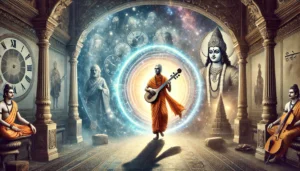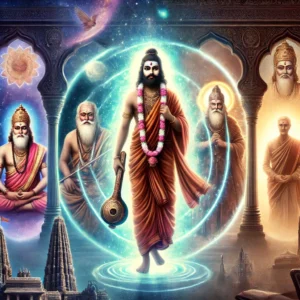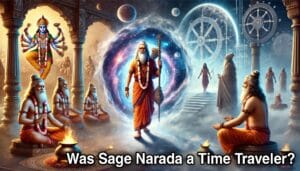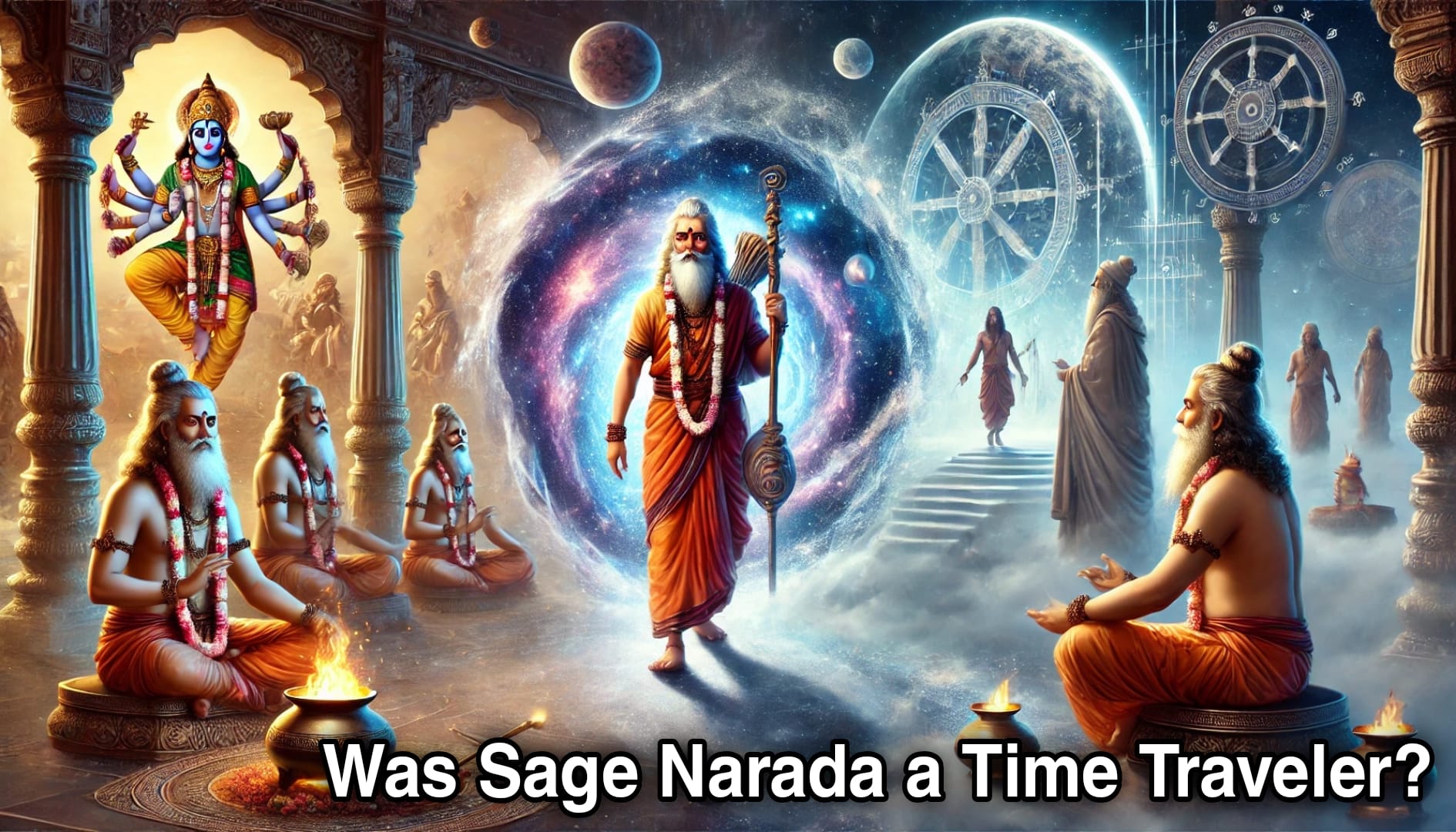
Was Sage Narada a Time Traveler?
Was Sage Narada a Time Traveler? Exploring His Appearances Across Ages
Sage Narada is one of the most intriguing figures in Hindu scriptures. Described as a celestial sage, a divine messenger, and a cosmic wanderer, he possesses the unique ability to travel across different realms—Swarga (heaven), Bhuloka (earth), and Patala (netherworld). What makes Narada even more mysterious is his consistent presence across multiple Yugas (epochs), from the Satya Yuga to the Dvapara Yuga and even references in the Kali Yuga.
This raises an interesting question: Was Sage Narada a time traveler? How did he appear in different time periods without aging, and how did he possess knowledge of past, present, and future events? Could ancient Hindu scriptures hint at the concept of time travel long before modern science even considered it?
In this article, we explore Narada’s unique appearances across different Yugas and examine the possibility of him being a time traveler through the lens of Hindu cosmology, quantum theory, and mystical yogic powers.
Narada’s Presence Across Different Yugas
- Narada in Satya Yuga: The Eternal Messenger
In the earliest Yuga, the Satya Yuga, Narada is already described as an enlightened sage, a great devotee of Lord Vishnu, and a celestial musician. His knowledge and devotion set the foundation for the concept of Bhakti Yoga (the path of devotion). He is also believed to have composed the Narada Bhakti Sutra, a revered text on devotion and divine love.
Narada is often portrayed visiting various divine realms, guiding sages and gods alike, and even influencing cosmic events. Since this is considered the “Golden Age,” where beings lived for thousands of years, it might explain his longevity. However, his presence remains constant even as Yugas transition, suggesting something beyond just longevity.
- Narada in Treta Yuga: The Influencer of the Ramayana
In the Treta Yuga, Narada’s influence continues. He plays a key role in shaping one of the greatest epics, the Ramayana.
- It is said that Narada meets Sage Valmiki and narrates the divine qualities of Lord Rama, inspiring him to compose the Ramayana.
- He also interacts with Lord Rama himself, advising him on the duties of a king and foretelling the events that would unfold in his life.
- In another story, Narada’s interactions with Ravana indirectly set the stage for the demon king’s downfall. He warns Ravana about the dangers of his arrogance and devotion to power, but Ravana ignores him—eventually leading to his destruction at the hands of Lord Rama.
Here, we see Narada not only appearing in a new Yuga but also influencing key events that shape history.
- Narada in Dvapara Yuga: The Mahabharata Connection
Narada’s role in the Dvapara Yuga is perhaps the most well-documented. He is frequently mentioned in the Mahabharata, where he serves as a divine counselor to both the Pandavas and Kauravas.
- He warns Duryodhana about his arrogance and pride, much like he did with Ravana in Treta Yuga.
- He advises Yudhishthira on the principles of dharma (righteousness) and governance, ensuring the path of justice prevails.
- He interacts with Lord Krishna on several occasions, discussing cosmic events and the grand design of the universe.
Narada’s presence in both Ramayana and Mahabharata, despite the vast gap between them, hints at an ability to transcend time. Could he be moving between epochs using divine or scientific means unknown to us?

Was Sage Narada a Time Traveler?
Table of Contents
- Narada in Kali Yuga: A Continued Presence?
Many believe that Narada still exists in the present age, the Kali Yuga, guiding sincere seekers toward the path of devotion. Various Hindu texts suggest that great sages do not truly “die” but continue to exist in higher realms, appearing in the mortal world when needed.
There are several legends and anecdotes in modern times where devotees claim to have had visions or encounters with Sage Narada. Could this mean he still roams the universe, performing his divine duties?
Is Narada a Time Traveler? Possible Explanations
- Celestial Being Beyond Time
According to Hindu cosmology, celestial beings (devas, rishis, and divine sages) do not experience time in the same way as humans. Their existence is beyond the linear constraints of time. For example:
- One day in Brahma Loka (the realm of Lord Brahma) is equal to 4.32 billion years on Earth.
- Devas and great sages like Narada can move freely between different realms, existing in a different temporal reality.
This could explain how Narada appears across Yugas without aging—his experience of time is different from ours.
- Quantum Physics and Time Travel
Modern physics suggests that time travel may be possible through time dilation, wormholes, and higher dimensions.
- Time Dilation: If a being travels at speeds close to the speed of light, time slows down for them relative to others. This could allow Narada to travel across epochs while experiencing only a short passage of time himself.
- Wormholes: Theoretical physics suggests the possibility of shortcuts through spacetime, allowing one to move between different points in time instantly. Could Narada be using some cosmic pathways unknown to modern science?
3. Multidimensional Existence
Some spiritual traditions suggest that highly evolved beings can exist in multiple dimensions at the same time. Narada’s ability to appear instantly wherever he is needed might indicate he has mastered the art of multidimensional travel.
- Yogic Powers (Siddhis) and Time Manipulation
Ancient Hindu scriptures speak of yogic powers known as siddhis, which enable advanced sages to perform supernatural feats, including:
- Anima: The ability to shrink to a microscopic size.
- Mahima: The ability to expand infinitely.
- Vashitva: The power to control nature and cosmic forces.
- Kaala Gati Gyan: The ability to perceive and manipulate time.
If Narada had mastered such siddhis, he could have been traversing time and space at will.
Conclusion: Eternal Guide or Cosmic Wanderer?
Sage Narada’s appearances across different Yugas challenge our conventional understanding of time. Whether he was a divine messenger with cosmic access, a being beyond time, or even an ancient time traveler using unknown scientific principles, his role remains unique in Hindu tradition.
His presence in different epochs, ability to foresee future events, and constant movement across realms suggest that Narada was no ordinary sage. Perhaps he represents a higher form of consciousness that exists beyond human limitations.
Even today, Narada’s wisdom continues to guide spiritual seekers, and his legacy as a divine wanderer remains alive. The idea of Narada as a time traveler opens a fascinating perspective, merging mythology with modern science. Maybe, in the vast universe, he still roams—watching, guiding, and shaping destinies.
What do you think? Was Sage Narada a time traveler, or did he transcend time itself? Share your thoughts in the comments!

Was Sage Narada a Time Traveler?
FAQs on “Was Sage Narada a Time Traveler? Unraveling His Mysterious Presence Across Ages”:
- Who was Sage Narada?
Sage Narada is a revered figure in Hindu scriptures, known as a divine messenger, musician, and devotee of Lord Vishnu. He appears in various yugas (ages) in different scriptures, often conveying messages and influencing events.
- Why is Sage Narada considered a time traveler?
Narada is mentioned in multiple scriptures across different yugas, from Satya Yuga to Kali Yuga, without any mention of aging or rebirth. His ability to appear instantly in different places and times raises speculation about his role as a cosmic traveler.
- What scriptures mention Narada’s presence in different eras?
Sage Narada is a key figure in Mahabharata, Ramayana, Puranas, and Upanishads. He is seen advising Dhruva in Satya Yuga, guiding Prahlada in Treta Yuga, influencing Lord Rama’s story, and even appearing in Mahabharata events.
- Does Hinduism support the concept of time travel?
Yes, Hinduism has many references to time being non-linear. Concepts like “Kalachakra” (wheel of time) and stories of sages experiencing different time scales suggest that ancient Indian thought entertained time travel-like ideas.
- Is Narada’s ability to appear in different eras divine or scientific?
Depending on the perspective, Narada’s ability can be seen as a divine blessing (granted by Lord Vishnu) or an example of advanced spiritual or scientific understanding of time and space.
- What role does Narada play across different yugas?
Narada is often seen as a divine communicator and catalyst. He inspires devotion, conveys messages between gods and humans, and sometimes even causes events to unfold, leading to greater cosmic purposes.
- Are there other figures in Hinduism associated with time travel?
Yes, figures like King Kakudmi and his daughter Revati, who visited Brahmaloka and returned to find ages had passed on Earth, are often cited as time-travel-like instances in Hindu texts.
- What can we learn from Narada’s travels?
Narada’s ability to traverse time and space teaches the importance of divine wisdom, devotion, and the interconnectedness of all yugas. His presence across ages signifies the eternal nature of knowledge and dharma.
- How does Narada’s role connect with modern scientific theories on time travel?
Some interpret Narada’s ability to move across time and space as an ancient depiction of wormholes, quantum entanglement, or the theory of relativity. Einstein’s time dilation theory suggests that time moves differently in different realms—something that aligns with Hindu cosmology.
- Has Narada been mentioned in modern contexts or Kali Yuga?
Yes, Narada is believed to exist even in Kali Yuga, inspiring spiritual seekers and guiding devotees through his timeless wisdom. Some also believe his essence continues through music, devotion, and knowledge-sharing in various forms.
Summary
Sage Narada, one of the most enigmatic figures in Hindu mythology, is known for his remarkable presence across different Yugas (epochs) and his ability to travel freely between worlds. He is often described as a celestial sage (Devarishi) who plays a crucial role in shaping historical and spiritual events in texts like the Ramayana, Mahabharata, and various Puranas. This raises an intriguing question: Was Sage Narada a time traveler, or did he possess a unique divine ability to exist beyond the constraints of time?
In Hindu scriptures, Narada is depicted as a wandering sage who moves effortlessly between the mortal, celestial, and divine realms, delivering messages and influencing key moments in history. His appearances in different epochs suggest an almost timeless existence, making him one of the few figures who interact with avatars of Lord Vishnu across different ages. For example, he advises Lord Rama in Treta Yuga and later appears in Dwapara Yuga to counsel Krishna and the Pandavas. This continuity challenges our conventional understanding of time and existence.
Some interpretations suggest that Narada’s ability to transcend time is due to a divine boon, allowing him unrestricted movement across dimensions. Others propose that he represents a cosmic force of wisdom and guidance, which manifests whenever the universe requires his presence. Some even speculate that his stories hint at concepts like time dilation or interdimensional travel, ideas that modern physics explores today.
Beyond mythology, Narada’s role as a celestial traveler can be seen as symbolic. He embodies the flow of knowledge and cosmic truth, moving beyond the barriers of time and space to carry divine messages. Whether one views him as an actual time traveler or a metaphysical representation of wisdom, his presence across Yugas continues to intrigue scholars, spiritual seekers, and even those curious about ancient concepts of time and reality.
By unraveling the mysteries of Sage Narada, we delve deeper into the rich tapestry of Hindu cosmology, where time is not linear but cyclical, and sages like Narada serve as bridges between different epochs, shaping the destiny of the universe.
Unlock the Ancient Wisdom of Sanatan Dharma – Join Us on YouTube!
👉 Subscribe now to Prachin Sanatan Dharma and embark on a journey of enlightenment.
Explore timeless teachings, spiritual insights, and cultural richness on our YouTube channel, Prachin Sanatan Dharma. Dive deep into the essence of Sanatan Dharma through captivating videos that inspire and educate.
Related Articles
- Restful Nights: Ayurvedic Remedies and Traditional Indian Practices to Overcome Insomnia and Late-Night Habits
- The Tridevi: Lakshmi, Saraswati, and Parvati – Their Roles and Powers
- “Divine Creatures of Ancient Indian Scriptures: Exploring the Role of Animals in the Vedas, Puranas, and Mahabharata”
- Nature and Spirituality: Exploring the Sacred Essence of the Himalayas, Ganga, and Other Natural Wonders”
- “Reviving the Gurukul System: Relevance and Lessons for Modern Education”
- “Exploring Greek and Indian Mythology: Similarities Between Greek and Indian Mythology “
- “Embracing Sattvic Living: Harmonizing Mind, Body, and Soul Through Food and Lifestyle”
- “Charity and Prosperity: Exploring the Concept of Daan and Its Financial Relevance in Modern Life”
- How to Build an Eco-Friendly Home Inspired by Vastu Shastra
- Comparison of Ancient and Modern Sports: How Traditional Sports Have Influenced Contemporary Games
- “Timeless Lessons from Ancient Tales: Linking Samudra Manthan and Ganga’s Descent to Modern Ecological Challenges”
- “Reviving Sanskrit: How AI is Preserving Ancient Languages for the Future”
- “Mathura: The Sacred Land of Lord Krishna’s Divine Leelas”
- Investing for Future Generations: Lessons from Indian Traditions on Legacy Building and Wealth Preservation
- “Ancient Indian Wisdom: Timeless Lessons for Tackling Today’s Climate Crisis”
- “Artificial Intelligence and Spirituality: Transforming Ancient Practices for the Modern World”
- “Gold and Real Estate in India: Timeless Assets Shaping Financial Strategies”
- Tradition Meets Innovation: The Evolution of Technology in Hindu Rituals
- End-of-World Myths: Exploring Kali Yuga in Hinduism and Ragnarök in Norse Mythology
- Garuda, Pegasus, and Dragons: The Universal Ties of Mythical Beasts Across Cultures
- “Ancient Vimanas: Mythical Flying Machines or Evidence of Advanced Technology?”
- Time Travel in Hindu Mythology: The Fascinating Tales of Kakudmi and King Raivata
- “Divine Feminine Power in Hindu Mythology: The Legends of Durga, Saraswati, and Lakshmi”
- “Divine Beings of Sanatan Dharma: The Spiritual Significance of Sacred Animals in Hinduism”
- “Symbolism in Mythological Art: Unlocking Hidden Meanings in Ancient Temple Carvings”
- “Exploring Technological Advancements in Ancient India and Civilizations: Vimana, Metallurgy, & Water Management systems”
- Unveiling the Mysteries: Ancient Temples of Sanatan Dharma , Mysterious Temples of India
- “The Scientific Knowledge of Sanatan Dharma: Ancient Wisdom Meets Modern Science”
- Ancient Indian Sports and Games: Celebrating a Legacy of Skill, Strength & Strategy”
- “Exploring the Cosmic Link: The Connection Between Astronomy and Vedic Astrology”
- The Power of Sanskrit: Unlocking the Divine Language of the Gods
- “The End of Kaliyuga: A Sanatan Insight into the World’s Final Chapter”
- Explore more articles on Prachin Sanatan Yuga.
Was Sage Narada a Time Traveler? Was Sage Narada a Time Traveler? Was Sage Narada a Time Traveler? Was Sage Narada a Time Traveler? Was Sage Narada a Time Traveler? Was Sage Narada a Time Traveler? Was Sage Narada a Time Traveler? Was Sage Narada a Time Traveler? Was Sage Narada a Time Traveler? Was Sage Narada a Time Traveler? Was Sage Narada a Time Traveler?
Was Sage Narada a Time Traveler? Was Sage Narada a Time Traveler? Was Sage Narada a Time Traveler? Was Sage Narada a Time Traveler? Was Sage Narada a Time Traveler? Was Sage Narada a Time Traveler? Was Sage Narada a Time Traveler? Was Sage Narada a Time Traveler? Was Sage Narada a Time Traveler? Was Sage Narada a Time Traveler? Was Sage Narada a Time Traveler?
